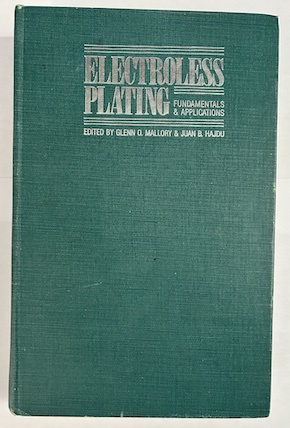
Curated with aloha by
Ted Mooney, P.E. RET

The authoritative public forum
for Metal Finishing 1989-2025

-----
Electroless nickel on copper
Q. Right now we plate electroless nickel on steel and aluminum, but our customer has a new request electroless nickel on copper, somebody know wich is the best way to apply EN on copper?
Gabriel RamirezGDO plating shop - Guadalajara Mexico
September 8, 2010
A. Hi, Gabriel.
Copper is not catalytic for electroless nickel, so you need to apply current for a couple of seconds to seed the process. Then remove the power and it should plate fine. Good luck.
Regards,

Ted Mooney, P.E.
Striving to live Aloha
finishing.com - Pine Beach, New Jersey
September 8, 2010
A. Hi Gabriel,
Besides electrolytic start-up, you may apply catalyst (normally is palladium type, either H2SO4 or HCl base, 50-100 ppm Pd, immersion time 1-3 mins) before EN. Process flow as below:
Cleaner--> Rinses--> Mild Etch--> Rinses--> Predip--> Catalyst--> Postdip--> Rinses--> EN--> Rinses
Regards,
David

David Shiu
- Singapore
September 10, 2010
|
|
A. Palladium activation is too expensive and only necessary for non-conductive materials. Additionally to what Ted advised, another way is to nickel strike the parts electrolytically in a separate tank properly equipped with anodes and bus bars, then after a thorough rinse move to the EN plating tank. Even if the strike does not fully cover the entire copper surface it will promote many catalytic sites. A well balanced top speed EN bath will take care of that. Monterrey, NL, Mexico A. Hi Gabriel,  T.S.N. Sankara Narayanan - Chennai, Tamilnadu, India (ed.note: The good doctor offers a fascinating blog, "Advancement in Science" ) |
Thanks a lot for your responses, I thought nickel strike is good way, many thanks again.
Gabriel Ramirez- Guadalajara, Jalisco, Mexico
September 24, 2010
Dear Gabriel,
Please share the outcome of your trials and your experience on this forum. It will help others.
Good luck

T.S.N. Sankara Narayanan
- Chennai, Tamilnadu, India
(ed.note: The good doctor offers a fascinating blog, "Advancement in Science" )
September 29, 2010
Q. Hi,
Can someone explain, WHY exactly copper is not a catalyst for EN but e.g. Pd is?
Thanks.
- Magdeburg, Germany
April 16, 2012
A. Thomas,
Pd is much more noble than Cu. If my memory is correct, Cu has a potential of .337V, Pd is .987V. For galvanic corrosion to take place, (Cu giving way to the Pd) dissimilar metals of nobility must be used. Pd and Ru are common catalysts used for Electroless Nickel on Cu for this reason.
Engineering - Mesa, Arizona, USA
April 24, 2012
Q. Mark.
Thank you for your answer. I can understand why Pd is depositing on Cu. It is a replacement reaction related to the galvanic series as you mentioned (less noble material is replaced by more noble material until the whole surface is covered by the noble material - self limiting process). However, I can still not understand why the Ni is depositing on Pd but not on Cu (galvanic series is not the reason since Ni is less noble than Pd - the deposition mechanism is different as well - autocatalytic vs. replacement). So my question unfortunately remains - why is Pd catalytic for Ni and why is Cu not catalytic for Ni?
Thank you for your help,
Thomas.
- Magdeburg, Germany
April 26, 2012
A. Hello Thomas,
Sorry my answer was off-path a bit. Cu will not catalytically initiate hypophosphite, when employed as the reducing agent in EN solutions. Cu can initiate when aminoborane and borohydride reducing agents are used however. Hope this helps.
Engineering - Mesa, Arizona, USA
April 30, 2012
Q. Mark,
Thank you again for your answer. OK - copper is catalytically active for aminoborane and borohydride nickel. Still I do not understand why Cu will not catalytically initiate eg. hypophosphite nickel, but Pd does? What is the exact criteria for a surface to be catalytically active or not. There must be a (chemical) reason/theory/explanation when and why a surface A is (or is not) catalytic for a autocatalytic deposition of material B?
- Magdeburg, Germany
May 4, 2012
A. Hi, Thomas. I think Mark has answered as best he can, and I can't improve upon it. But based on his informative answer, I would suggest that perhaps it's not the nickel (material B) that you should be looking towards, but the hypophosphite? That is, I think the question may be "why do Pd, Fe, &Ni -- but not Cu -- trigger the oxidation of hypophosphite"?
Regards,

Ted Mooney, P.E.
Striving to live Aloha
finishing.com - Pine Beach, New Jersey
May 4, 2012
A. Ted,
Thank you for your comment on the E-Less Ni questions from Tom. I believe it's the difference in the activity of the metals when it comes into contact with hypophosphite. Our shop plates EN but I am by no means an expert. I've been in this business for over 30 years and still have questions from our suppliers. I wish some of our employees would ask the WHY question more often. Thanks again.....
Engineering - Mesa, Arizona, USA
May 8, 2012
Q. I am using a 316 stainless copper brazed plate heat exchanger in a home drinking water distillation project. Unfortunately, the copper is being extracted by the steam during condensation. I am thinking of plating the entire heat exchanger to seal off the copper. The maximum temperature is 110C with a flow rate of less than 7 gallons per hour. What material and process is recommended?
Rich Kessler- Richmond, California, USA
April 28, 2012
A. By copper, I assume that you are talking about a high copper content alloy.
You might have better luck with bronze for a braze. Personally, for 316, I would TIG weld it with 316L rod.
Orbital welders do a fantastic hob on tubes. They will not work on horizontal tube to vertical header. That will require hand welding or CNC welding.
- Navarre, Florida
May 10, 2012
Q. Sir,
I want to know if sodium hypophosphite is used in electroless copper baths along with formaldehyde on Printed circuit boards.
I will be very thankful if I will be advised on this.
Sonali Kokane
- Thane, Maharashtra, India
February 26, 2013
A. Hi Sonali. I've never heard of it myself.
If there was anything I never wanted to be, it was a dentist :-)
Please tell us the situation behind your question. Thanks.
Regards,

Ted Mooney, P.E.
Striving to live Aloha
finishing.com - Pine Beach, New Jersey
February 27, 2013
|
Q. Sir, - Thane, Maharashtra, India March 3, 2013
March 4, 2013
A. How are you Sonali? - Riyadh, Saudi Arabia |
Q, A, or Comment on THIS thread -or- Start a NEW Thread
